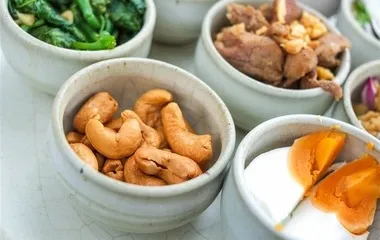New Year's fruit salad meal is refreshing and detoxifying
Recommendation for this issue: New Year's Colorful Fruit Salad

apple half medium; about 52 calories

1 small tomato; about 18 calories

dragon fruit half (medium); about 38 calories
Excipients:

1 small green pepper, about 28 calories

carrot half (small), about 9 calories
Seasoning:

Total calories: 72.5 calories/person-more calories query your body needs calories
New Year's Colorful Fruit Salad-Principles of Weight Loss During the Spring Festival, many people eat big fish and meat, which are high in calories and greasy. Eating too much will affect their appetite. Nutrition experts suggest that during the Spring Festival, we should consciously eat more fruits and vegetables, supplement vitamins, adjust taste, and balance nutrition.
Fruits and vegetables are rich in fiber, make them feel full and can effectively control appetite. For example, apples, tomatoes, dragon fruit, green peppers, and carrots have quite low calories. Appropriate supplements every day are both nutritious, slimming, and have cosmetic effects. They are the best way to lose weight during the Spring Festival.
New Year's Colorful Fruit Salad-Steps to Make

1 Preparing materials
Prepare apples, carrots, tomatoes, dragon fruit, green peppers, wash them, and salad dressing (or your favorite sauce).

2 Lay lettuce on the plate
Wash the lettuce and lay it on a plate for later use.

3 Cut fruits and vegetables
Cut apples, tomatoes, and dragon fruit into diced shapes, cut peppers into flower-shaped shapes, and place on a plate.

4 Cut carrots
Cut the carrots into grains or blocks (the carrots are listed separately here, because some people don't like the taste of carrots and it is difficult to disperse the carrots when cut in large pieces, so cut the carrots as small as possible).

5 Cold salad
Put the chopped apples, carrots, tomatoes, dragon fruit, and green peppers in a basin, pour with your favorite sauce, and mix well.

6 Completed
Place the mixed fruits and vegetables on a paved lettuce plate. The colorful fruit salad with beautiful colors and delicious taste is ready.
Share it on my Weibo
Nutrition expert comments

This issue's consultant Zhang Ailing, weight loss case manager and full-time diabetes nurse, colorful New Year fruit salad. The colors are rich and beautiful, the luster is attractive, and it is very festive, adding to the Spring Festival atmosphere.
Weight loss in winter, pay attention to balanced nutrition
Zhang Ailing: The pectin and tannic acid in apples have astringent effects and can expel toxins and waste accumulated in the intestines; the lycopene in tomatoes can reduce the body's caloric intake and reduce fat accumulation; dragon fruit juice can prevent constipation and bowel cancer, lower cholesterol, help skin whitening, and lose weight.>> See more ways to lose weight